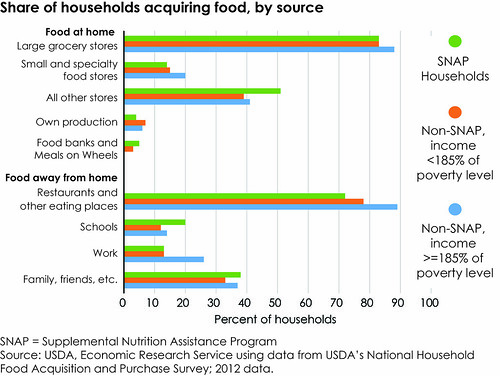
USDA’s Economic Research Service (ERS) has developed a unique treasure trove of data from a survey on food purchases and acquisitions by U.S. households - USDA’s National Household Food Acquisition and Purchase Survey FoodAPS. To protect individual survey respondents’ privacy, access to the data had been restricted to researchers from academic institutions and government agencies. Now, a modified version that aggregates information so individuals cannot be identified, but still provides valuable data for research and planning is available to everyone.
What can FoodAPS data tell us? USDA’s investment in FoodAPS was undertaken to fill a critical knowledge gap and encourage research that can support an evidence-based approach to Federal food assistance policies and programs. The data are being used to address a range of questions such as where households acquire food in a typical week, which foods they acquire, how much they pay for the food and how the acquired foods match recommendations for a healthy diet.
What makes FoodAPS data unique? FoodAPS is the first nationally representative survey of American households to collect data on food purchases and acquisitions from all sources, including grocery stores, restaurants, workplaces and schools as well as data on food acquired free of charge (e.g., food banks, friends). The nearly 5,000 sampled households include low-income households and participants in the Supplemental Nutrition Assistance Program (SNAP), making the data particularly valuable to policy makers and program managers. In addition, FoodAPS links food acquisitions with detailed information about the local food environment (e.g., number of food stores near respondents’ locations) and nutrients in the food acquired by the respondents over a seven-day period.
To broaden access to the FoodAPS data, ERS has posted pubic-use files on the ERS website that users can download in several file formats. To protect the identity of the surveyed households, identifying variables (like place names and specific locations) are removed and others are slightly modified (like categorizing a person’s age).
Who will find FoodAPS data useful? In addition to policy makers and academic researchers, potential users include nutrition advocacy organizations, state and local agencies that address food-related issues, and journalists covering nutrition and food security topics. We invite potential users to explore this unique dataset.
USDA has invested $19 billion in research and development since 2009, touching the lives of all Americans from farms to the kitchen table and from the air we breathe to the energy that powers our country. Learn more about the many ways USDA scientists are on the cutting edge, helping to protect, secure and improve our food, agricultural and natural resources systems in USDA’s Medium Chapter 11: Food and Ag Science Will Shape Our Future.
